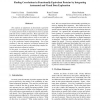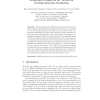110 search results - page 12 / 22 » Alternative splicing and protein function |
BMCBI
2006
14 years 11 months ago
2006
Background: Proteins that are similar in sequence or structure may perform different functions in nature. In such cases, function cannot be inferred from sequence or structural si...
111
click to vote
BMCBI
2006
14 years 11 months ago
2006
Background: Recent progress in cDNA and EST sequencing is yielding a deluge of sequence data. Like database search results and proteome databases, this data gives rise to inferred...
120
Voted
BIBE
2006
IEEE
15 years 5 months ago
2006
IEEE
The analysis of alignments of functionally equivalent proteins can reveal regularities such as correlated positions or residue patterns which are important to ensure a specific f...
122
click to vote
EVOW
2012
Springer
13 years 7 months ago
2012
Springer
Abstract. The hydrophobic-polar (HP) model for protein structure preabstracts the fact that hydrophobic interactions are a dominant force in the protein folding process. This model...
92
Voted
ISVC
2007
Springer
15 years 5 months ago
2007
Springer
Abstract. The function of a protein is dependent on whether and how it can interact with various ligands. Therefore, an accurate prediction of protein-ligand interactions is paramo...


